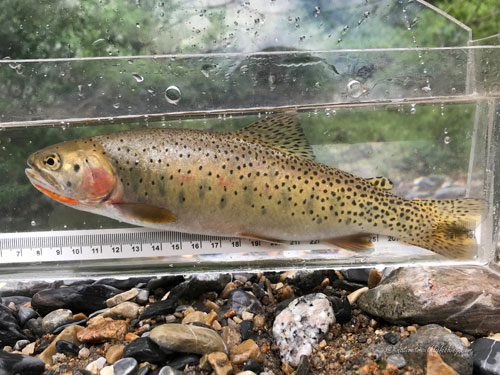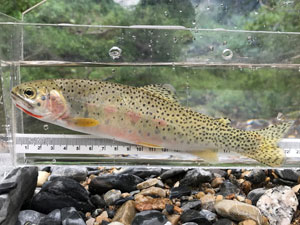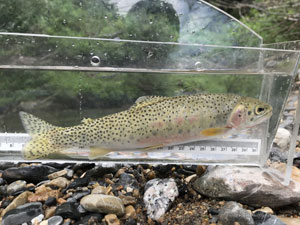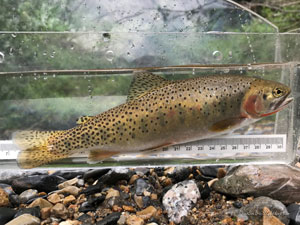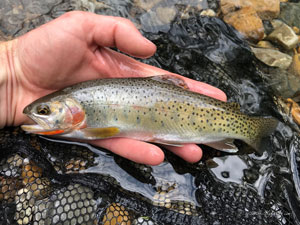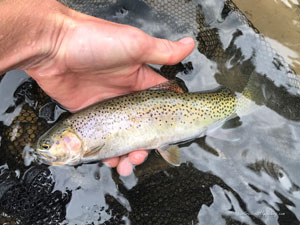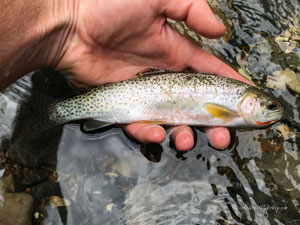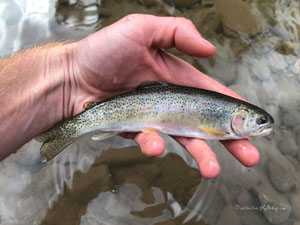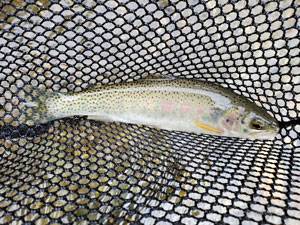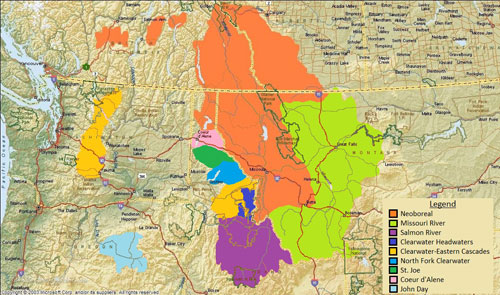Missouri River Westslope Cutthroat
Oncorhynchus lewisi ssp.
A stream resident Missouri River Westslope Cutthroat from a Montana stream.
Introduction
The Missouri River Westslope Cutthroat is native to the Missouri River drainage from the Judith River upstream to the headwaters. The Missouri River Westslope Cutthroat were the first form of Westslope Cutthroat brought to the attention of the scientific community. Their discovery occurred when Captain Meriwether Lewis of the Lewis and Clark expedition described trout caught by a member of the expedition near the Great Falls of the Missouri River in Montana on June 13th, 1805. Naturalist George Suckley returned to this spot almost a half-century later and caught several Missouri River Westslope Cutthroat on dry flies, which he named "Salar lewisi" in honor of Captain Meriwether Lewis (Behnke 2002). For years Westslope Cutthroat Trout were classified as a single subspecies (Behnke 1992, Behnke 2002, Trotter 2008), however genetic evidence shows high levels of diversity within the Westslope Cutthroat Trout genome, indicating the presence of nine distinct subspecies (Trotter et al. 2018). Based on genetic analysis, the Missouri River Westslope Cutthroat are most closely related to Neoboreal Westslope Cutthroat from the Flathead River drainage, which until 1913 shared a connection to the upper Two Medicine River, which is a tributary to the Missouri River, allowing geneflow between the two watersheds (Young et al. 2018).
Life History Information
The Missouri River Westslope Cutthroat historically primarily displayed stream resident and fluvial (river migrant) life histories, with adfluvial (stream to lake migrant) forms also historically found in a number of lakes. However, today nearly all remaining populations are stream resident forms. The adfluvial Missouri River Westslope Cutthroat have been extirpated from all the large lakes they once inhabited and there is very little information on the characteristics of fluvial life histories, but it is thought they are similar to those of other Westslope Cutthroat subspecies.
Stream resident Missouri River Westslope Cutthroat typically reach a maximum size of around 12” (30 cm) and an age of up to 8 years old (Behnke 2002). These fish are opportunistic feeders and prey primarily on aquatic and terrestrial invertebrates. Male stream resident Missouri River Westslope Cutthroat begin to reach sexual maturity at age-2 with all maturing by age-4, generally when they are 4 to 6” (11 to 16 cm) long. In contrast females begin to reach sexual maturity at age-3 with most becoming mature by age-5 at 6 to 7” (15 to 18 cm) long (Downs 1995). Female stream resident fish generally produce between 227 to 459 eggs, depending on the length of the fish (Downs et al. 1997). Cutthroat in a small stream in the upper Gallatin River drainage, were observed migrating upstream for spawning between mid-May to early June when water temperatures reached 44.6 to 48.2 °F (7-9° C) (Magee et al. 1996). After reaching their spawning grounds, spawning typically takes place once water temperatures reached 46.4 °F (8 °C), typically between late-May and mid-July depending on elevation, with females remaining in spawning tributaries for 11 days and males for 9 days.
Status
Among the subspecies of Westslope Cutthroat Trout, the Missouri River Westslope Cutthroat have been the most heavily impacted. Shepard et al. (1997) showed that in the Missouri River drainage Westslope Cutthroat occupied in less than 5% of their historic range and of the 144 remaining populations 71% were at a very high risk of extinction. Since the review in 1997, some progress has been made preserving and reintroducing populations of Missouri River Westslope Cutthroat, but many populations have been lost or remain at high-risk, with pure populations occurring in less than 3% of their historic range in Montana as of the last status review (Arnold et al. 2017). Remaining populations are relegated to small, isolated headwater streams and there has been a near complete loss of the fluvial life history type. The culprits for the decline of Missouri River Westslope Cutthroat are similar to those impacting other types of inland salmonids can be primarily pinned on the introduction of non-native fish, overfishing and habitat degradation. In 1997 Westslope Cutthroat, including the Missouri River Westslope Cutthroat were petitioned to be listed as under the Endangered Species Act. However, primarily due to healthier of populations of the other subspecies of Westslope Cutthroat, it was determined that listed status was not warranted (USFWS 1996, USFWS 2003).
Since the arrival of Europeans in their native range in the 1800’s, Missouri River Westslope Cutthroat Trout have been impacted by habitat destruction and overfishing. Habitat destruction occurred due to mining, logging, agriculture, and road construction and resulted in deteriorated water quality, higher temperatures and sedimentation in many watersheds. This resulted in lower rates of successful spawning and made waters less hospitable to Cutthroat, which rely on cold clean water. In addition to habitat impacts, liberal harvest regulations resulted on Cutthroat that are highly susceptible to angling resulted in depleted populations. To address the diminishing Cutthroat populations and to “improve” the quality of fisheries, fisheries managers turned to hatcheries and introduced non-native trout species.
The introduction of non-native trout species has had the most significant impact on the Missouri River Westslope Cutthroat. Unlike other subspecies of Westslope Cutthroat, which coevolved with other salmonid species such as Bull Trout, Redband Trout and Pacific Salmon, for the most part Missouri River Westslope Cutthroat were the sole species of trout or char found across their native range (the exception being a few Lake Trout populations). Rainbow, Brown and Brook Trout have been introduced across the upper Missouri River basin and impact Westslope Cutthroat populations through competition, predation and hybridization. Rainbow Trout and Brown Trout have replaced most Missouri River Westslope Cutthroat populations in low to mid elevation streams, while Brook Trout have impacted headwater populations. Brook Trout, which are fall spawners emerge earlier than spring spawning Cutthroat fry imparting the juvenile Brook Trout with a competitive advantage over Cutthroat. Shepard et al. (2002) illustrated the level of impact competition with Brook Trout can have on Westslope Cutthroat based on a study on a small stream in the Missouri River drainage. In 1990 when the study stated, Brook Trout were the dominant fish in the stream and the entire population of Westslope Cutthroat consisted of only 80 individuals over 3” (7.6 cm). To address the low abundance of Cutthroat, Brook Trout were removed from the stream between 1993 and 2000, resulting in the Westslope population increasing to approximately 480 fish over 3” (7.6 cm) per mile of stream.
Some of Montana's most famous Rainbow and Brown Trout fisheries, such as the Madison, Gallatin, Big Hole, Beaverhead and Missouri Rivers were once home to thriving Westslope Cutthroat populations and show the extent to which these native trout have been replaced. Rainbow Trout have a survival advantage of Missouri River Westslope Cutthroat Trout at higher water temperatures and can tolerate water temperatures of 8.5° F (4.7° C) higher that Westslope Cutthroat, which has been a factor in displacing these Cutthroat in lower elevation streams (Bear et al. 2007). Brown Trout also have similarly high temperature tolerance (Elliot 1973) and become highly piscivorous once they reach a large enough size (Behnke 2002, Meredith et al. 2014). Beyond direct competition and predation, Rainbow Trout pose a significant threat to Westslope Cutthroat through hybridization. Hybridization has resulted in either hybrid swarms or complete replacement of many Westslope Cutthroat populations. In Yellowstone National Park, the replacement of Westslope Cutthroat was so thorough that of their 640 miles (1,031 km) of historic habitat, Westslope Cutthroat were only found in 1.2 miles (2 km) prior to the implementation of restoration efforts (Arnold et al. 2017). The two remaining populations of Westslope Cutthroat Trout in Yellowstone National Park were discovered in 2005 and since tier discovery the Park Service has implemented an aggressive reintroduction program. Once the planned restoration program is complete, Westslope Cutthroat distribution in the park will have increased from 1.2 miles (2 km) to 84 miles (135 km), with major reintroductions in the East Fork Specimen Creek, Grayling Creek and the upper Gibbon River already completed (Arnold et al. 2017). The reintroductions in the East Fork Specimen Creek and Grayling Creek appear to be successful, with natural reproduction taking place and fish beginning to recolonize the lower portions of the watersheds (Puchany 2021). While, the Missouri River Westslope Cutthroat still has a long road to recovery, efforts like those in Yellowstone National Park provide rays of hope for conserving this subspecies into the future.
Description
The Missouri River Westslope Cutthroat Trout are similar in appearance to other Westslope Cutthroat, although they often have drabber coloration. However, their coloration does vary across populations and environmental conditions. The coloration on the backs and sides of these fish is typically an olive, bronze or even grayish color. The side of these fish range from a grayish color to tan or bronze and the bellies and gill plates typically show a peach to bright orange color and this same color may be found along the lateral line, often between the parr marks on smaller individuals. Spots are typically irregularly shaped, small to medium sized and concentrated towards the posterior region of the body and along the back with relatively few spots found below the lateral line in the middle of the body. Their fins typically are a yellow to orange or peachy color and spots are typically found on the dorsal, adipose and caudal fins.
Stream Resident Form
Click on images to view a larger picture
Native Range
Above: A map of the native range of the Westslope Cutthroat trout. Data Sources: Behnke (2002), Trotter (2008) and Young et al. (2018). Below: A map of the native range of the Missouri River Westslope Cutthroat Trout.
References
Arnold, J.L., C.R. Detjens, B.D. Ertel, M.E. Ruhl and T.M. Koel. 2017. Westslope cutthroat trout and fluvial arctic grayling restoration. Yellowstone Science 25(1): 18-25.
Bear, E.A., T.E. McMahon and A.V. Zale. 2007. Comparative thermal requirements of Westslope Cutthroat Trout and Rainbow Trout: implications for species interactions and development of thermal protection standards. Transactions of the American Fisheries Society 136: 1113-1121.
Behnke, R. J. 1992. Native trout of western North America. American Fisheries Society Monograph 6. American Fisheries Society, Bethesda, Maryland.
Behnke, R. 2002. Trout and Salmon of North America. Chanticleer Press, New York.
Downs, C.C. 1995. Age determination, growth, fecundity, age at sexual maturity, and longevity for isolated, headwater populations of westslope cutthroat trout. Masters Thesis. Montana State University. Bozeman, Montana.
Downs, C.C., R.G. White and B.B. Shepard. 1997. Age at sexual maturity, sex ratio, fecundity, and longevity of isolated headwater populations of westslope cutthroat trout. North American Journal of Fisheries Management 17:85-92.
Elliot, J.M. 1973. The food of brown and rainbow trout (Salmo trutta and S. gairdneri) in relation to the abundance of drifting invertebrates in a mountain stream. Oecologia 12: 329-347.
Magee, J.P., T.E. McMahon and R.F. Thurow. 1996. Spatial variation in spawning habitat of cutthroat trout in a sediment-rich stream basin. Transactions of the American Fisheries Society 125:768-779.
Meredith, C.S., P. Budy and G.P. Thiede. 2014. Predation on native sculpin by exotic brown trout exceeds that by native cutthroat trout within a mountain watershed (Logan, UT, USA). Ecology of Freshwater Fish 24(1): 133-147.
Puchany, A.R. 2021. Success of Westslope Cutthroat Trout and Artic Grayling conservation translocations in Yellowstone National Park, Montana and Wyoming, USA. Masters Thesis. Montana State University, Bozeman, Montana.
Shepard, B.B., Sanborn, B., Ulmer, L. and Lee, D.C. 1997. Status and risk of extinction for westslope cutthroat in the Upper Missouri River Basin, Montana. North American Journal of Fisheries Management 17: 1158-1172.
Shepard, B.B., R. Spoon and L. Nelson. 2002. A native westslope cutthroat population responds positively after brook trout removal and habitat restoration. Intermountain Journal of Sciences 8(3) 193-214.
Trotter, P. 2008. Cutthroat: Native Trout of the West. Second Edition. University of California Press, Berkley, CA.
Trotter, P., P. Bisson, B. Roper, L. Schultz, C. Ferraris, G.R. Smith and R.F. Stearley. 2018. A special workshop on the taxonomy and evolutionary biology of cutthroat trout. Pages 1-31 in Trotter P, Bisson P, Schultz L, Roper B (editors). Cutthroat Trout: Evolutionary Biology and Taxonomy. Special Publication 36, American Fisheries Society, Bethesda, Maryland.
USFWS. 1996. Endangered and threatened wildlife and plants; notice of final decision on identification of candidates for listing as endangered or threatened. FR 61:65581-64485.
USFWS. 2003. Endangered and threatened wildlife and plants: reconsidered finding for an amended petition to list the Westslope Cutthroat Trout as threatened throughout its range. FR 68:46989-47009.
Young, M.K., K.S. McKelvey, T. Jennings, K. Carter, R. Cronn, E.R. Keeley, J.L. Loxterman, K.L. Pilgrim and M.K. Schwartz. 2018. The phylogeography of westslope cutthroat trout. Pages 261-301 in Trotter P, Bisson P, Schultz L, Roper B (editors). Cutthroat Trout: Evolutionary Biology and Taxonomy. Special Publication 36, American Fisheries Society, Bethesda, Maryland.
Contact
Feel free to contact me if you have any questions or comments
Missouri River Westslope Cutthroat Trout Links
My Missouri River Westslope Cutthroat Trips
Montana Fish, Wildlife and Parks - Westslope Cutthroat Trout
Yellowstone National Park - Westslope Cutthroat Trout
Helena and Lewis and Clark National Forest
Custer-Gallatin National Forest
Red Rock Lakes National Wildlife Refuge
Western Native Trout Initiative - Westslope Cutthroat Trout
Native Trout Links
Truchas Mexicanas' - Native Trout of Mexico
Balkan Trout Restoration Group
Trout and Seasons of the Mountain Village - About Japanese Trout
Western Native Trout Challenge
California Heritage Trout Challenge
Fly Fishing Blogs
Dave B's Blog: Fly Fishing for Native Trout
The Search for Native Salmonids
Conservation Links
Western Native Trout Initiative
Fly Fishing Links
Fishing Art Links
Americanfishes.com - Joseph R. Tomelleri
